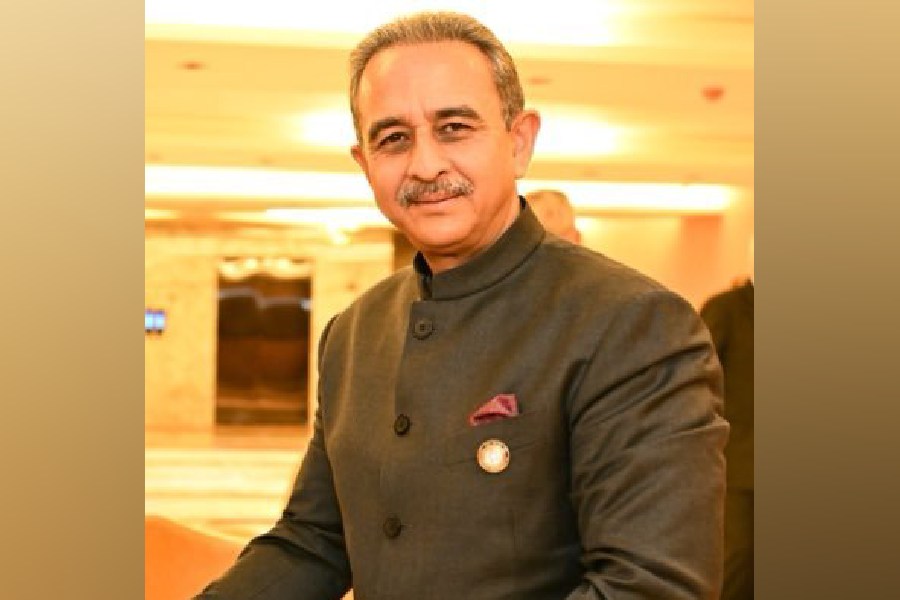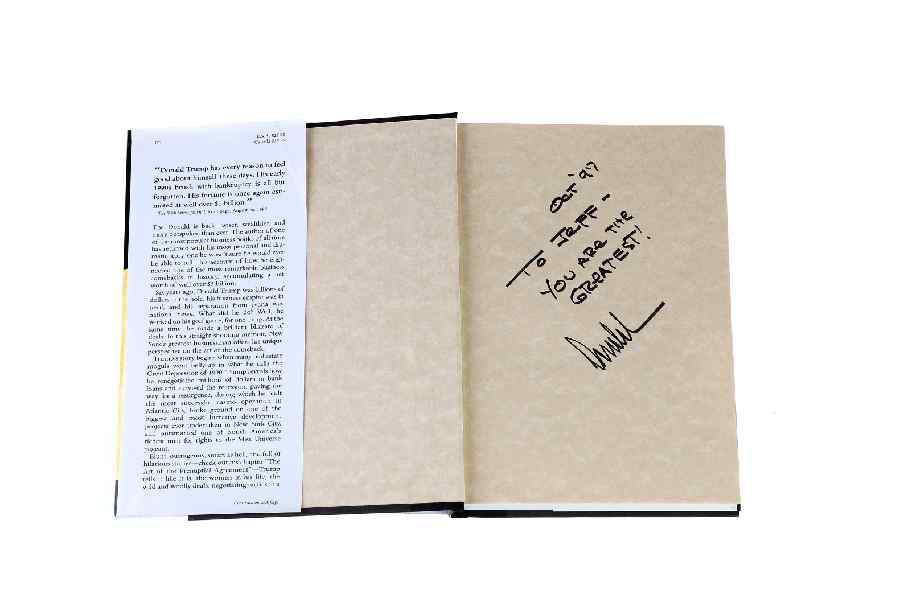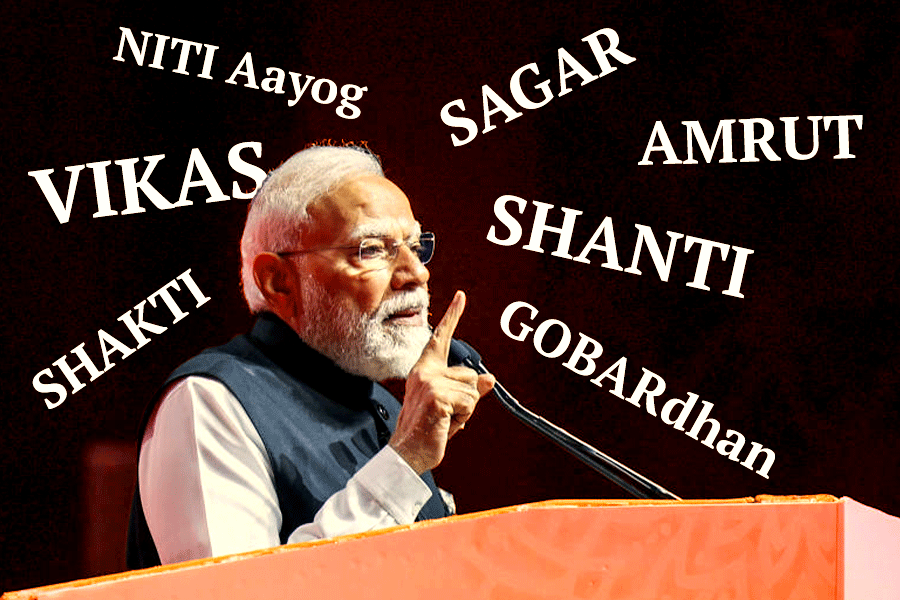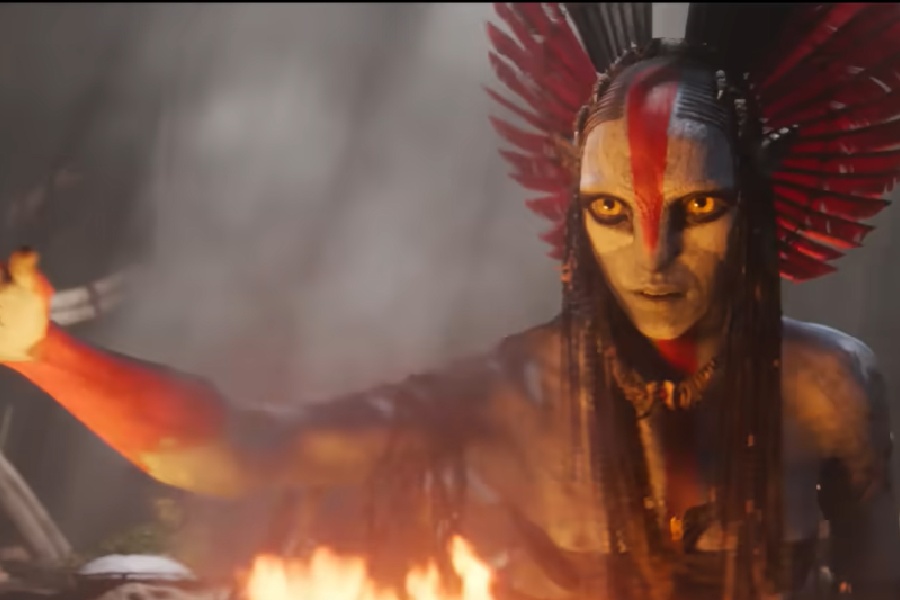Much like his films, there is something intoxicatingly chameleonic about Wim Wenders’s persona. So chameleonic that you feel that most of the characters he has lovingly crafted live inside him. Whether it is Travis Henderson, who travels from Chaplin-esque outcast to tragic hero in Paris, Texas, or the quietly meditative Hirayama of Perfect Days. When he smiles, it’s a full smile. When he chuckles, you see his eyes dancing behind his spectacles. He speaks softly but emphatically. Much like his cinema.
A major figure in New German Cinema, Ernest Wilhelm ‘Wim’ Wenders, 79, has, over the course of more than five decades, established himself as a voice to reckon with in world cinema. Among the honours he has received are awards from the Cannes, Venice and Berlin film festivals. He has also received a BAFTA Award and has been nominated for three Academy Awards and a Grammy Award.
Recently, Wenders was in Calcutta for ‘King of the Road’, a retrospective of his most impactful films that has seen the filmmaker travel to five cities in what is his maiden trip to India. An initiative of Film Heritage Foundation, under the aegis of its founder-director Shivendra Singh Dungarpur, ‘King of the Road’ has seen houseful audiences from Delhi to Mumbai, Calcutta to Thiruvananthapuram, with scores of admirers lining up to watch his films and hear Wenders speak about his cinema and beyond.
In between his hectic schedule in the city, the filmmaker, who started off as a painter and still dabbles in photography, sat down with t2oS for a conversation at Taj Bengal.
What has it been like in Calcutta, especially with respect to the kind of response from fans of your films at the screenings?
Some of them were very knowledgeable. It was almost scary how much they knew about me! It took me quite by surprise. Shivendra (Singh Dungarpur, founder-director of Film Heritage Foundation) had told me about it, but I thought he was exaggerating!
Film is a very, very popular art form in India. I know people still go to theatres here in large numbers, unlike in Europe where theatres are in a crisis right now. There is great enthusiasm for cinema and the cinematic form here. It is beautiful to see that.
‘King of the Road’ travelled to Mumbai and Thiruvananthapuram before you came with it to Calcutta. How has it been so far in India on what is your maiden visit?
I had a great first impression of India in Mumbai. Besides the screenings and Q&As, we had a masterclass and a round-table discussion with more than 50 Indian filmmakers. Some of them are now in Berlin (for the Berlin International Film Festival). It is a little strange that I met them just before they left for Berlin, while I was just coming from Berlin. I wished them good luck and I hope they come back with some awards. We had a two-hour-long fantastic talk between the Indian film professionals and myself. I was quite overwhelmed.
We then went to Thiruvananthapuram, which I thought would be a little sleepy southern place. But the Kerala audiences were also quite knowledgeable, with some quite fancy questions that I had never got before in my life! That always says a lot about an audience. Kerala was altogether a beautiful experience. Now I am back in the big city, Calcutta. Finally! I waited for so long for this moment.
Have you had a chance to get a feel of the city?
I have not seen much of Calcutta yet, but what I have seen is tremendous. It seems like a very energetic city and I am looking forward to being on my own for a few hours, walking around and getting lost (smiles). That is what I like to do... simply walk around. Eventually, you can always just take a taxi. But I am looking forward to taking a walk with my wife... she is a great explorer as well, and the only one I like having around me when I am taking pictures (smiles). Otherwise, I need to be alone by myself to take photographs.
I have seen a number of films shot here in Calcutta. I am so happy that the same Ambassador yellow taxis are still around. In lesser numbers, but they are still here. In Mumbai, I didn’t see a single old car. Kerala had a few old HM cars left, but only one of them was in good condition. I love the yellow taxis in Calcutta... it is like New York where you used to see the old yellow taxis, but now you get to see them only in the movies.
Your earliest brush with the city was meeting one of its most famous sons — Satyajit Ray — at the Berlin International Film Festival in 1973. What are your memories from that interaction?
I met Ray at the Berlin International Film Festival in 1973 where his film Distant Thunder (Ashani Sanket) was playing. I saw him all by himself in the festival lobby, drinking coffee, and approached him with a beating heart. But he was very gentle and asked me to join him, so we could talk. I remember he was a towering figure. I am quite tall myself, but he was really, really tall. I think he was happy to talk with somebody for a while. The official photographer of the festival even took a picture of us together, without us realising. She gave me the print later. I really wanted to bring that picture to India, but my team (at Wim Wenders Foundation) packed it away and kept it so well that eventually we couldn’t find it! (Laughs)
I was looking forward to showing it here in India because I was very proud of it. It was the first time I was meeting one of the great directors I admired. Years later, I also met (Francois) Truffaut. Much, much later, I met Nicholas Ray and some of my American heroes but among these great authors of cinema, Ray was the very first I encountered in person.
I remember being very nervous but he was so nice and gentle. We spoke for a long time and something told me he was happy speaking to a film person and not just the press. I asked him a lot about the film that was in competition in Berlin. It eventually won (the Golden Bear, the biggest honour at the Berlin festival) and I remember how excited I was that it was him holding the trophy.
I love his The Music Room (Jalsaghar, 1958). I had it as a VHS, I had it as a DVD. I now have it as a Blu-Ray. So I feel I have seen it in all shapes and forms. And now, one can have it with these nice subtitles and as a beautiful restoration. When I get back home to Germany, I will rewatch my whole Ray box set. On this trip, I have had the privilege to see his house and meet his son (Sandip Ray).
What was your initial reaction when your were told that ‘King of the Road’ was being planned? Are you someone who likes revisiting your work?
Shivendra and I were both in Bologna for a week to see restored films. Both of us have great expertise in the field (of restoring films) and with my foundation, we have now restored 23... not just my own films, but also a few others. When he found out that I had never been to India, he said I absolutely needed to come. But I was always sure that if I ever travelled to India, it couldn’t be for a short period like a film festival. I said to Shivendra: ‘Well, if I am coming, we better make it a month, because that is what I promised myself.’
I didn’t want to just go to one city... I wanted to get a feeling of India. I also wanted to make sure that my wife and I had a little time off on our own. And he said that we could do all of this. He sent us the first draft of where we would go. He made a suggestion of movies we could have at the retrospective and I put in a few names that I thought were missing. In the end, it ended up being quite an extensive retrospective with 12 films.
I watched Paris, Texas (1984) at Nandan and I don’t think I have seen it look so beautiful, with its 4K beamer and really fantastic sound. In these moments, you realise how much it is worth it to restore films and not show some scratchy old print that has faded colours. We are very proud of this 4K restoration because we worked on it for months and months.
Of course I find flaws in my work. But flaws are something good. I don’t like movies with no flaws... perfect films can be so boring.
I like rewatching my films, now that I know they are in good shape... I know they are well taken care of and they will survive me. And they are on their own. I produced almost all my films and owned them. But ownership is overrated, I feel. Why own them if they could own themselves? And the idea of a foundation, I liked it that out of all the profit... nobody gets anything... no library, no producer. Nobody gets anything out of the profits of some of these films. All the money goes back into the restoration of other films. So these films now have a future in front of them... they can take care of themselves. I now have a much better relation to my movies because I feel they are set free... they are now adults and can do well without us.
The new generation is discovering your films now. Is their reaction to your films different from those who watched it in the ’70s and ’80s?’
Oh yes, it is a whole different generation. When we showed the restored version of Paris, Texas for the first time at Cannes Classics, the audience was comprised almost entirely of people who had never watched it before. But at Nandan, half the audience knew the film. Indian audiences, as I said, are very cultivated. But in Cannes, almost none of them had seen it. It was all young people. I stayed and saw it with them and I felt that the film had aged well. It is still contemporary, because it is not a genre film and is not based on any model. It is a film with its own roots and its very own unique story. Maybe that is why it has survived so well.
We live in an era of enormous changes of our society, of our own psychology, of who we are as people, how we deal with each other. We have realised that the digital era which started so hopeful has turned into another direction than we anticipated. Storytelling is disappearing... instead of storytelling, we are now in an age of story selling. Movies, in many ways, for a whole new generation, is a form of information and no longer a form of storytelling. And if you see a film on your mobile phone or on your computer, you see something else. You see something that is leveled by everything else you see on that platform. And movies no longer have the innocence of storytelling.
That is why I am amazed by how much people in India still go to see movies in theatres. It is almost a dream come true for somebody who lives in Europe where a lot of theatres are facing a very hard time because the pandemic has helped to propel audiences away out of theatres into their homes where they see all the information they want. Consuming is the enemy of storytelling. But I don’t think it is hopeless. Cinema has a lot of transformative power and it has proven so in its 130 years. Cinema also has a healing power. And sometimes, I feel we have to rely on the healing power of the theatre experience.
You have a rich and diverse filmography, with Paris, Texas being one of your most striking and celebrated early films. What is the story behind you wanting to make the film?
It was a film about America like nobody had ever made before. Americans make movies about America that are very, very different. They were not used to filmmakers from other parts of the world shooting “in their own territory”, and the reaction in America at the time when the film came out was like that. They said: ‘We don’t need other people to show us who we are and how we live’. American film crews go everywhere in the world — they shoot in Italy, they shoot in Germany, they shoot all over the place. They take the liberty to show the world. But if people come to them, they are irritated. Some of the reaction at the time was downright hostile. ‘We don’t need Europeans to show us America! We know it a bit better’.
Actually, I think they were surprised at what we had accomplished. Sam Shepard (the film’s writer) was an outsider in American cinema, but one of the great contemporary American writers of the 20th century, at least in theatre. He knew the American West like his own pocket! His knowledge of America and my look at it... and Robbie Muller’s images of it as our DoP, then Ry Cooder’s archetypal blues soundtrack, none of that was any trodden path. We all had a fresh look at America and the American Dream. And for some Americans, I think even today, it is still shocking how different a view Paris, Texas is.
You had once said: ‘Filmmaking should be a way of life, driven only by curiosity.’ Is that sense of curiosity still alive even after so many decades?
I learned that making a film from experience, only because you know how to do it, doesn’t produce anything too interesting. I learned that experience is nothing you can count on and rely upon. It is better to make a film because you do not know how to make it than thinking: ‘Oh I can handle this, I can do this, I know how to do it.’
In the course of time, I have slowly moved to making films strictly because I do not know yet how to make the next one. The success of Paris, Texas was a great burden for me at first because, of course, everybody wanted me to do another one just like it. It took me three years, the longest pause after any movie of mine, because I had to learn how to deal with that expectation, before I could make another film. In the end, I did the very opposite with the next one, Wings of Desire (1987). You can’t really think of something more opposed to Paris, Texas as Wings of Desire.
I realised this was healthier. That I could survive better as a filmmaker if I made every film from scratch and invented its own rules and its own vocabulary. Perfect Days (2023) is also like nothing I have ever done, and I don’t quite think there is anything like it.
You said in an interview two years ago that you don’t like the current state of cinema and what it has been producing. Has that view remained the same or changed now?
I think that viewpoint has changed a bit, because filmmakers all over Asia, in India, in Korea, in Japan... young filmmakers have realised that you cannot compete with Netflix and you cannot really find your own voice if you make a film following any rules or doing it with any of the usual recipes. The great movies I have seen over the last few years were all very original and invented their own rules.
I think that is the only way to survive. If you are a young filmmaker and you have to find out what your voice is, you better not model it on anything that is around, that has been done before. Because the streamers do nothing anyway but recycle movies.
And if you even look at the studios, they are all at ‘Batman number 22’. Movies are a franchise business now. Who wants to see that?! Who wants to be responsible for making something new in there? It is strictly a recycling business. I mean, of course, you can still do ‘interesting variations’, but it is not creative. I think original storytelling for young filmmakers is the only way to make a name for themselves.
WIM’S ‘WON’DERS
Alice in the Cities (1974)
A German journalist and a girl left in his care embark on a search for the child’s grandparents. That is the simplistic breakdown of the first film in Wenders’s Road Movie Trilogy (the other two being Wrong Move and Kings of the Road), whose richness and depth of cinematography and characterisation brush away any signs of preachiness and sentimentality. A freewheeling look at friendship, loneliness and life, this black-and-white film has ideas and aesthetics that have defined the director’s career and craft over the last few decades.
Paris, Texas (1984)
A deeply-felt neo-Western about relationships broken and fused, Paris, Texas is distinguished by Robert Muller’s cinematography and Ry Cooder’s pulsating soundtrack, but mostly by Wim Wenders’s almost meditative treatment of a subject that transcends road movie archetypes and becomes a mythic quest for healing and reconciliation.
Wings of Desire (1987)
Bringing a true poetic sensibility to the medium of cinema, this award-winning film depicts life in a divided Berlin through the eyes of angels. Hailed for being a cinematic achievement, Wings of Desire is a celebration of the transient moments of being human. ‘The film evokes a mood of reverie, elegy and mediation’ is how critic Roger Ebert described it.
Pina (2011)
A hypnotic 3D capture of iconic choreographer Pina Busch’s work and legacy. Pina melds documentary with dance, making for a spellbinding portrait of an artiste, with Wenders’s skilful filmmaking highlighting that art never dies. Watching Pina feels like being inside one of Busch’s surreal dances, and that is where Wenders’s true win lies.
Perfect Days (2023)
Wenders’s latest directorial is an absorbing slice-of-life drama, a quiet portrait of a man who has chosen to lead a simple life in the chaotic hustle and bustle of Tokyo. Exquisitely filmed and beautifully enacted, Perfect Days sees Wenders return to his stylistic origins and deliver a film that captivates with its subtle beauty, the essence of being, and celebrates life’s little joys.










